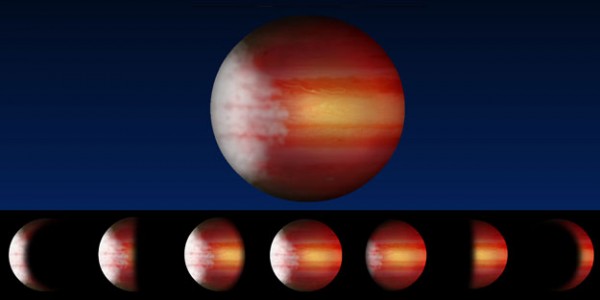Astronomers Can Now Predict Weather on Distant Planets
| Ana Verayo | | May 14, 2015 11:10 AM EDT |
(Photo : University of Toronto) An artist's rendering of an exoplanet with cloudy mornings and clear, scorching afternoons, exhibiting a cycle of phase variations that occur as different portions of the planet are illuminated by its star, as seen from Earth.
A space telescope specially designed to detect and observe distant exoplanets has apparently found strong evidence of weather patterns in alien worlds that will now allow astrophysicists to create alien world weather forecasts.
An international team of scientists from Canada and the United Kingdom has analyzed data from NASA's Kepler Space Telescope and have also idenitifed different weather variations and anomalies on six exoplanets.
Like Us on Facebook
Scientists observed "phase variations" from different parts of these planets when light bounces and reflected off from their host stars which is also similar to Earth's moon cycles going through different phases.
According to Lisa Esteves from the Department of Astronomy and Astrophysics of the University of Toronto, the team identified weather patterns of these alien worlds by taking measurements of these changes as the planets orbit their host stars and correctly determining a day-night cycle.
She also adds that the team has traced the cycle in phases when different regions of the planet are illumintaed by its star, from fully lit--daytime to complete darkness--night time.
Scientists have created "forecasts" from cloudy mornings among four of these exoplanets that ranges from clear yet scorching, extremely hot afternoons on two other planets.
These predictions are also based on the rotations that generate eastward atmospheric winds on the surface of the planets. These would cause the movement of clouds that has formed from the cooler side of the planet towards the daytime side that produces a "cloudy" morning forecast.
Esteves says that these winds also transport these clouds to the daytime side that heat up and dissipate, producing a clear afternoon sky. The winds also push the hot air eastward from the meridian during midday that results in higher temperatures during the afternoon.
Reseacrhers believe that the Kepler telescope is the most ideal instrument to study the different phase variations of extremely distant exoplanets.
According to Ernst de Mooij of the Astrophysics Research Center in Queen's University, Belfast, the detection of light that travelled from more than 100,000 light years away is truly remarkable as these phase cycle variations are also 100,000 times fainter than the host star making Kepler a very powerful telescope.
This study is published in The Astrophysical Journal.
TagsKepler space telescope, NASA, weather on exoplanets, predict weather distant planets, weather on alien planets
©2015 Chinatopix All rights reserved. Do not reproduce without permission
EDITOR'S PICKS
-

Did the Trump administration just announce plans for a trade war with ‘hostile’ China and Russia?
-

US Senate passes Taiwan travel bill slammed by China
-

As Yan Sihong’s family grieves, here are other Chinese students who went missing abroad. Some have never been found
-

Beijing blasts Western critics who ‘smear China’ with the term sharp power
-

China Envoy Seeks to Defuse Tensions With U.S. as a Trade War Brews
-

Singapore's Deputy PM Provides Bitcoin Vote of Confidence Amid China's Blanket Bans
-

China warns investors over risks in overseas virtual currency trading
-

Chinese government most trustworthy: survey
-

Kashima Antlers On Course For Back-To-Back Titles
MOST POPULAR
LATEST NEWS
Zhou Yongkang: China's Former Security Chief Sentenced to Life in Prison

China's former Chief of the Ministry of Public Security, Zhou Yongkang, has been given a life sentence after he was found guilty of abusing his office, bribery and deliberately ... Full Article
TRENDING STORY

China Pork Prices Expected to Stabilize As The Supplies Recover

Elephone P9000 Smartphone is now on Sale on Amazon India

There's a Big Chance Cliffhangers Won't Still Be Resolved When Grey's Anatomy Season 13 Returns

Supreme Court Ruled on Samsung vs Apple Dispute for Patent Infringement

Microsoft Surface Pro 5 Rumors and Release Date: What is the Latest?










